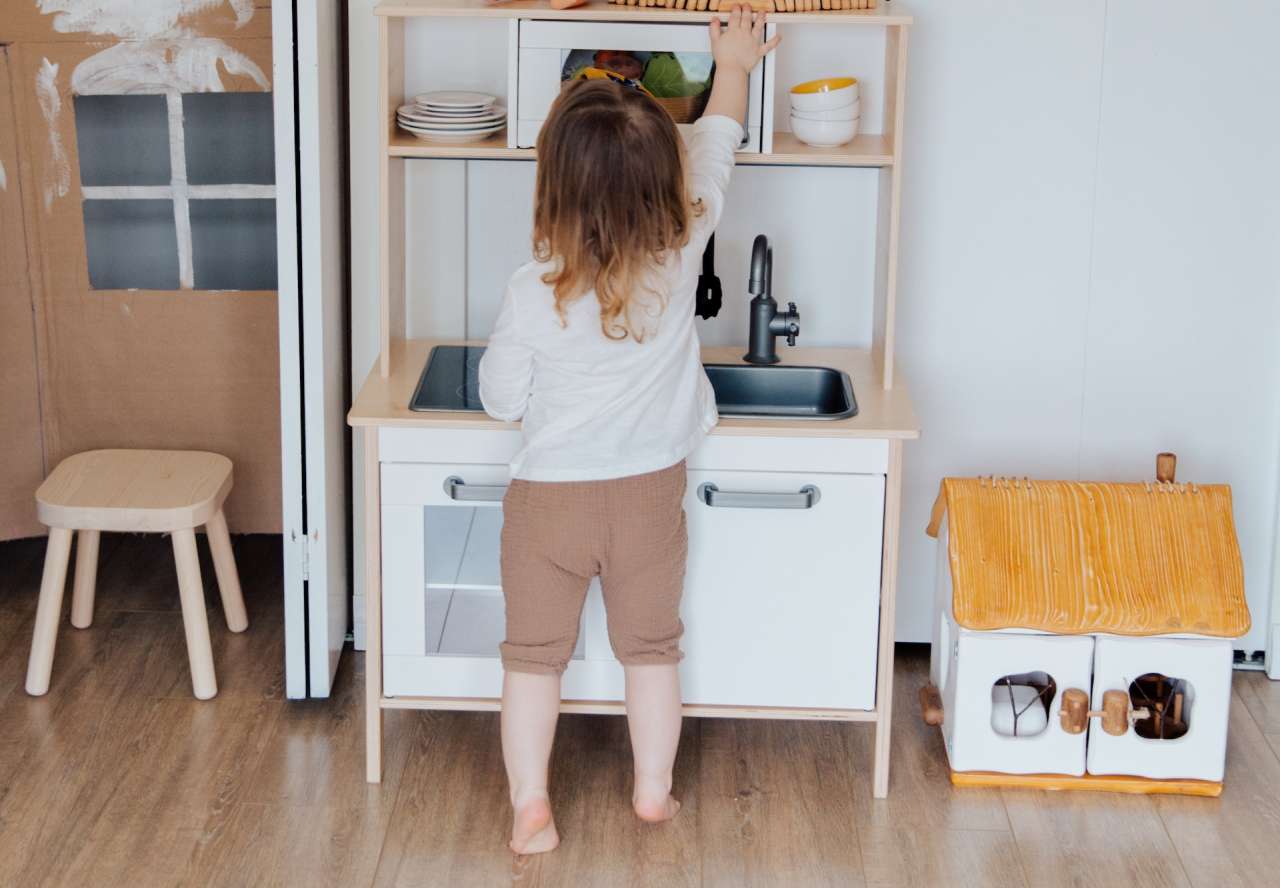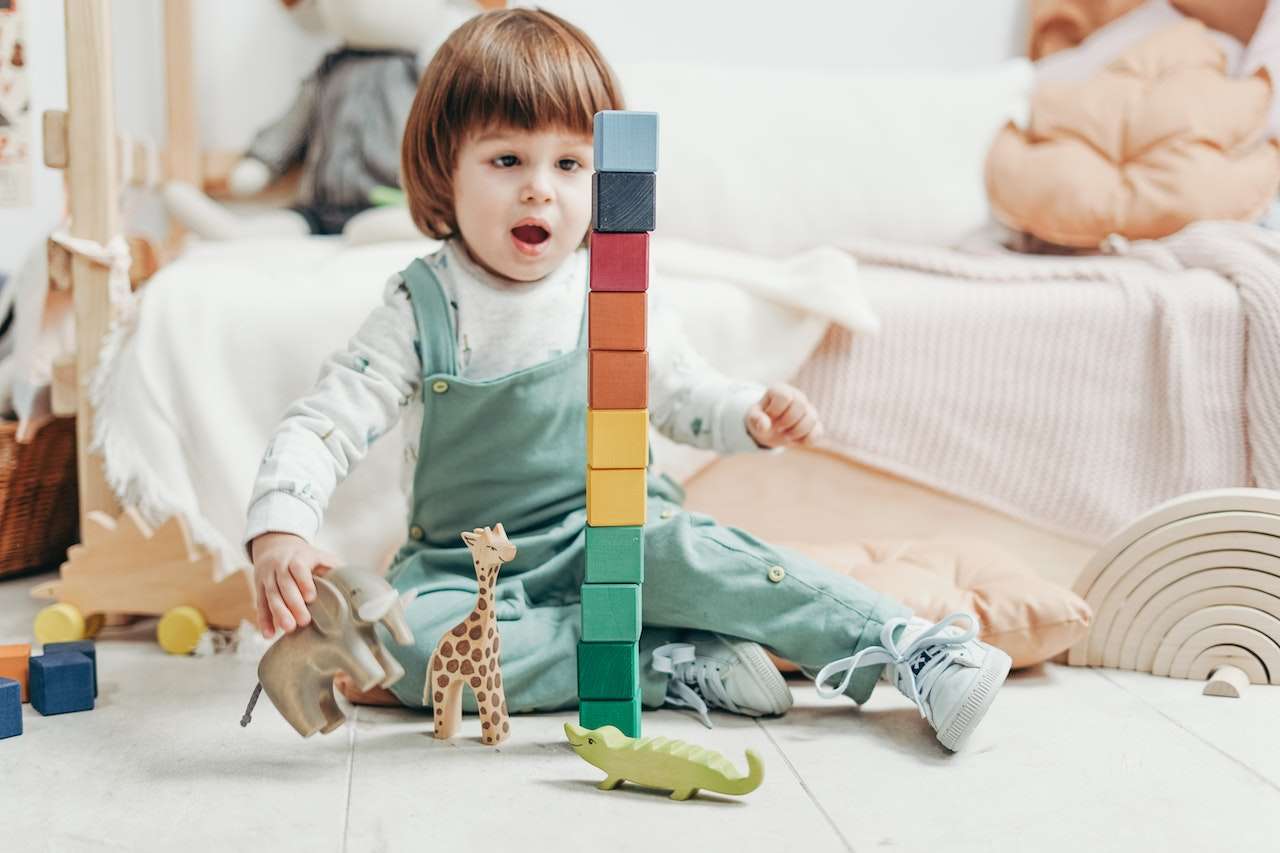With the soaring popularity of the Montessori Method of education, many parents feel the need to implement them at home.
As children grow up, they imitate the actions that you do. They love to play around the house exploring things. The kitchen is one of their favorite places where they pretend to work in the way they observe you doing chores.
Your daily activities in the kitchen may seem ordinary, monotonous, and redundant to you, but it’s new and exciting to your kid.
A kitchen is an ideal place to introduce Montessori principles to your child.
Are you looking for guidance on setting up a Montessori kitchen for your child?
To get started, let us first understand what a Montessori kitchen is.
What is a Montessori kitchen?
A Montessori kitchen is a functional space for the children to experiment with real-life activities like preparing food or cleaning.
It enables the children to learn about kitchen activities, encourages independence, and teaches table manners and dining with grace, etiquette, and politeness.
Many other practical life skills such as washing hands, pouring water, preparing food, and cutting vegetables and fruits can be introduced through the Montessori kitchen.
Getting familiar with actual kitchen activities should start in the Montessori kitchen.
It does get messy sometimes engaging kids in the kitchen. But it’s essential to teach them these skills early to develop independence. Additionally, there are many other benefits too.
Benefits of Montessori Kitchen
Cooking with kids is rewarding and comprises many learning experiences.
Although your child will learn from the practical life activities in a Montessori preschool, you can encourage these types of activities at home in a Montessori kitchen.
You can make your child learn in the kitchen by following age-appropriate activities.
A Montessori kitchen can benefit your children in more ways than one.
1) Encourage independence
Usually, the idea of children keeping away from the kitchen as they may break things deters their learning.
The Montessori approach is – a kitchen provides great opportunities for a child to learn new things and engage in everyday activities.
As they help you in food preparation, cleaning, and peeling vegetables, they develop a sense of independence and self-involvement.
2) Freedom of movement
One of the basic principles of Montessori is giving children the freedom to explore the world around them.
Before engaging your children in the kitchen, you can babyproof and create a friendly environment in the kitchen by removing dangerous items from their reach.
They can explore cooking and other activities with you in the Montessori kitchen.
3) Boosts self-esteem
You can offer a low cabinet where children can reach to keep things. It can boost self-esteem in children as they arrange utensils, fill a cup of water, and put away dishes.
When your child is involved in kitchen activities, they feel proud and confident, which will inspire them to attempt more tasks as they grow.
4) Develops fine motor skills
Many activities in the kitchen environment refine and develop the fine motor skills of children.
Activities like peeling and slicing, shelling peas, adding and mixing ingredients, kneading dough, and helping to set the table are some of them.
5) Encourages grace and courtesy
Children learn self-care, grace, and courtesy through table etiquette. You can encourage them to set up a table, learn to eat manners, wash their hands before eating, and say thank you and please.
6) Develop basic math and science skills
When you involve your child in cooking, you can help them learn math through measurements. You can also explain concepts in science like mixing ingredients and boiling water.
These practical life activities help toddlers understand the world around them and build a positive image.
When and how to introduce a Montessori kitchen to your child?
You can introduce the concept of a Montessori kitchen as early as infancy. As the children start walking and showing interest in cooking, cleaning, and other chores, they are ready for the Montessori kitchen.
There is no specific age for implementing it as the interest may vary from child to child. It may be 16 to 18 months for some kids.
Children enjoy watching you prepare meals and make dishes. But involving them in the kitchen is not safe for them.
Therefore, a Montessori kitchen at your home will help them emulate your actions in a secure environment.
You can introduce a Montessori kitchen to your children by guiding them in kitchen activities along with you.
Infants – They can be involved in activities like making dough or salt dough. You can guide children between the ages of one and two years in mixing the ingredients and kneading the dough.
Toddlers – Children under three years can absorb everything they experience in their environment. They can be involved in activities like adding and mixing ingredients, kneading dough, peeling, slicing, shelling peas, egg peeling, and slicing and helping to set the table.
You can also guide them to prepare and toss the salad for food preparation.
Preschool-aged children – Activities like squeezing orange juice, peeling and slicing vegetables, tossing salad, using a hand whisk, pouring water into a glass, and washing hands by turning the tap are appropriate for this age group.
Children in this age group can use kitchen appliances with your supervision and measure ingredients by measuring cups and spoons. They can follow simple recipe instructions too.
How to set up a Montessori kitchen at home?
A child’s Montessori kitchen should be realistic and functional. A Montessori kitchen should resemble your kitchen and feature natural aspects of it.
Non-functional cooking instruments do not help them to learn practical life skills.
There are plenty of kitchen spaces available to buy, but designing and building a Montessori kitchen for your child allows you to customize every detail of your child’s learning experience
A tall safe Step Stool or Learning Tower
It’s a safe and convenient tool that provides a raised platform that enables your child to be part of the cooking process. A step stool or learning tower can make your kitchen a Montessori-friendly place.
Kids get curious to see the activities on the kitchen counter. The stool helps your child get to your level and engage in kitchen activities.
Katanabana Kids Kitchen Step Stool Helper and WhittleWood Wooden Toddler are a few varieties that you can check out.
Low storage area
Regular-use items like cups, plates, and utensils can be made accessible to your child by keeping them on a low shelf or cupboard. They can easily reach for their stuff and arrange them on their own.
You can make them use the top of the storage to serve snacks and keep a water dispenser that your toddler can use.
Use child-sized cutlery of natural materials
Small kitchen tools and utensils fit into your child’s hands and are convenient for their use.
You can use cups, spoons, forks, and other utensils for your child made of natural materials like wood and steel instead of plastic.
There may be chances of breaking, but it teaches children to be responsible enough and handle fragile objects.
Cleaning materials
Make sure to provide them with a few kitchen towels, cloth napkins, a child-sized dustpan and brush, and a small trash bin to clean up spills. Children love wiping up spills and sweeping the floor.
Emphasize calmness and patience when they clean up messes. It teaches them that they are responsible for rectifying their own mistakes.
Seating
Instead of a high chair, a small table and chair will be convenient for your child. They can have a snack, arrange napkins, and even prepare food. A weaning table and chair can be a good option.
Functional kitchen for your toddler
You can repurpose the toy kitchen of your toddler into a Montessori kitchen in a compact space. It has features like a low storage area, a low counter, and a water source for washing.
Setting up a Montessori at home, especially in the kitchen, can be intimidating.
You can go slow in introducing each facet of the Montessori kitchen to your child and let them feel confident, capable, and joyful in the kitchen.


